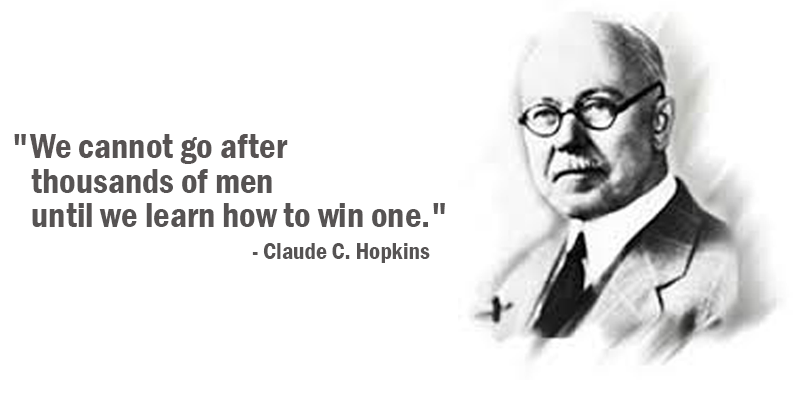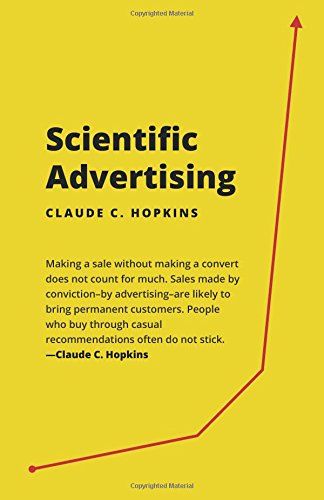4 (Still Relevant) Advertising Lessons from a 1923 Classic

“Advertising, once a gamble, has become, under able direction, one of the safest business ventures. Certainly, no other enterprise with comparable possibilities need involve so little risk.”[1]
The above quote is from Claude Hopkins who, in 1923, wrote the seminal advertising treatise, “Scientific Advertising”. He famously made toothpaste mainstream in America and helped Schlitz beer go from 8th to 1st by describing the rather mundane and standard process of brewing beer.
One could easily dismiss Mr. Hopkin’s confidently nonchalant claim as tshe self-promoting boast of a prototype ad man – a precursor to the 1960s Madison Avenue “Mad Men”.
But what if old Claude was onto something (other than promoting his own book sales)?
Claude Hopkins is widely considered the father of modern advertising. He widely extolled the virtues of using sampling, risk-free trials, money back guarantees, and market testing to increase the effectiveness of advertising campaigns.
He forcefully advocated that advertisers use those tools and ignore them at their peril. Hopkins argued, with great certainty, that advertising, through trial and error, has uncovered certain basic truths about advertising - what works well, what works poorly and what doesn’t work at all. He encapsulated these insights into his seminal work Scientific Advertising.
Scientific Advertising - A Perfect Product of its Era
Scientific Advertising reflects the advertising technologies that existed in 1923, namely that of direct mail, coupons, newspapers and magazines. When Scientific Advertising was published, radio and movies were in their infancy. The advertising business models for those two new mediums had not been fleshed out yet at the time of the book’s publication.
But, at the time of publication, the advertising business models for direct mail coupons and print ads in newspapers and magazines had been established for decades. Tens of thousands of ad campaigns of trial and error had already happened, testing what worked from what didn’t work. And the job of tracking the effectiveness of advertising with direct mail and newspaper and magazine ads was relatively straight forward.
As Hopkins correctly pointed out, one could measure how big a coupon was, what font it had, how big the type was, how many copies of that ad were published… etc. The advertiser could actually track and measure all of these important metrics that could tell him exactly how effective his advertising campaign was.

This is why Mr. Hopkins spoke with such certainty about the effectiveness of a properly run ad campaign. At the time Mr. Hopkins wrote, the technology, prior advertiser experimentations, and the mediums of advertising were aligned in the advertiser’s favor. But if, and only if, they chose to understand and apply the principles that Mr. Hopkins discussed in Scientific Advertising.
But then, the technology of mass media radically changed. At the time of Scientific Advertising’s publication, new mediums – radio and movies – grew from their infancy and into mass market appeal.
They became dominant new modes of American mass advertising. Through movies and radio, mass marketing to passive audiences became a true reality. While a consumer could choose to read a print ad or not, it proved much more difficult for a consumer to escape a product placement or sponsorship ad in a movie or a radio program.
The advent of these new mass media technologies – and the advertising business models they helped spawn – were also much harder to scientifically and systematically track the effectiveness of (who listens, who responds, the total consumer impact of an ad… etc.).
The advent of television in the 1950s further accelerated this trend. Within these new passive mediums, the pendulum within advertising and marketing swung back from scientific certainty towards opaqueness and marketing voodoo.
But then, with the invention of the Internet and online advertising, the marketing game radically changed again. The internet became the new dominant medium, and once again it became possible to track the exact effectiveness of online advertising via measuring clicks, consumer interaction and attention. Advertising became scientific again.
Claude Hopkins would have delighted in the Internet’s ability to reach and measure interactions with consumers. And with the certainty of the Internet’s tools for measuring consumers’ interactions with advertisements, the wisdom in Scientific Advertising took on a timely urgency.
Understanding Human Psychology
In Scientific Advertising, Hopkins goes to great lengths to stress the importance for an advertiser to understand human psychology. Hopkins implores advertisers to truly discover what people really want – on a basic human level – and then to find the levers to gain their attention.
Hopkins claims that advertisers must understand that human beings are innately curious, attracted to extravagance and luxury, and always will seek to reduce risk (thus the effectiveness of the money back guarantee).
He also states that consumers will respond well to deferred payments, personalization of a product, and often make purchasing decisions based upon their own subjective frame of reference. It seems very basic on the surface, but after deeper thought and analysis, the psychological levers mentioned above can be wildly different from one target market to another.
Hopkins also stresses that people respond well to specifics and stories in advertising. Once and advertiser has a customer’s attention, it is important to give specific details about how a product or service can benefit him or her.
For example, Hopkins points out that it is advertising malpractice for an advertiser just to claim that prices for the advertised product “have been reduced”. Instead, the advertiser must say how much the product’s prices have been reduced. Instead, Hopkins recommends the advertiser say, “prices have been reduced by 25 percent.”[2] Hopkins takes great pains to stress to the reader that people believe the specific.
Testing Advertising – Finding Truth through Using Inductive Logic
I believe that the most important insight from Hopkin’s Scientific Advertising his insistence on conducting test marketing cases before commencing any mass market advertising campaign and using that test data to as a guide to what works and what doesn’t work.
Hopkins pointed out that in the past (before his book was published), advertisers made large advertising budget decisions based upon their gut intuition. Hopkins viewed this as sheer folly. Hopkins opined that all the tools were already available to an advertiser to run market tests for an ad or ad campaign in a small, clearly defined market.
For example, an advertiser could test the effectiveness of a coupon ad by running it for a few days in the local newspapers of two or three small cities. To take this to another level, Hopkins suggested that an advertiser could run two or three different versions of a coupon ad in different newspapers in different towns of similar size.
Hopkins pointed out that this is the perfect way to test which coupon ad was the most effective ad with consumers. After the advertiser receives back sufficient data from the test runs (ad cost, response rate per ad, revenue generated per ad… etc.), the advertiser could plan the optimal mass market or national ad campaign for the product or service he is advertising.
What Hopkins was advocating (without stating it) is for advertisers to rely on a combination of deductive and inductive logical reasoning to determine the most effective way of reaching a consumer market. This is at the heart of the scientific method. It is therefore critically important to understand the difference between deductive and inductive logical reasoning.
Deductive reasoning is a basic form of valid reasoning. Deductive reasoning, or deduction, starts out with a general statement, or hypothesis, and examines the possibilities to reach a specific, logical conclusion.[3]
Deductive inference conclusions are certain provided the premises are true, but It is possible to come to a logical conclusion even if the generalization is not true. For example, the argument, "All bald men are grandfathers. Harold is bald. Therefore, Harold is a grandfather," is valid logically but it is untrue because the original statement is false.
Inductive reasoning makes broad generalizations from specific observations. In short, a person should go out and collect data relevant to a specific topic. Then the person should analyze that relevant data and draw conclusions from it. Inductive reasoning makes broad generalizations from specific observations. Basically, there is data, then conclusions are drawn from the data.
"In inductive inference, we go from the specific to the general. We make many observations, discern a pattern, make a generalization, and infer an explanation or a theory… …In science, there is a constant interplay between inductive inference (based on observations) and deductive inference (based on theory), until we get closer and closer to the 'truth,' which we can only approach but not ascertain with complete certainty." [4]
What Hopkins was advocating was revolutionary for the time. He argued that one should start with premise that seems deductively true - creating an ad that appeals to what the advertiser guesses that a consumer would respond to – and then going out and seeing how a test case of consumers actually respond to that ad.
Hopkins then suggests that the advertiser create many variations on this ad and measure how test markets respond to each ad. At the end, the advertiser should compare the metrics for all the tested ads and use the most effective ad in a national advertising campaign.
As Hopkins succinctly said himself, “Groping in the dark in this field has probably cost enough money to pay the national debt. That is what has filled the advertising graveyards.”[5] But happily, according to Hopkins, advertisers and marketers can avoid that grisly fate if they simply apply the scientific method to their advertising campaigns.
Scientific Advertising in the Internet Age
Hopkin’s book has taken on new and profound relevance as Internet based advertising has matured. Internet advertisers now can track the effectiveness of internet advertising in ways that are far beyond Hopkin’s wildest dreams in 1923.
Advertisers and marketers can collect a treasure trove of information about their potential customers and design ads that specifically appeal to their wants and desires. Furthermore, the transaction costs for running test internet advertising campaigns today pale in comparison to the efforts and advertiser had to go through over 90 years ago.
In 1923, Hopkins was an advertising visionary. He was a master of his craft and the advertising technology of the era. By 1980, the opaqueness of the new, passive advertising mediums (namely radio and tv) had reduced the relevance of Hopkin’s Scientific Advertising. But with the advent and maturation of internet advertising, once again the insights in Scientific Advertising have once again become the cutting edge.
[1] Claude C. Hopkins, Scientific Advertising, Really Simple Media, 1923, pg. 4. [2] Claude C. Hopkins, Scientific Advertising, Really Simple Media, 1923, pg. 35. [3] https://www.livescience.com/21569-deduction-vs-induction.html [4] https://www.livescience.com/21569-deduction-vs-induction.html [5] Claude C. Hopkins, Scientific Advertising, Really Simple Media, 1923, pg. 50.



